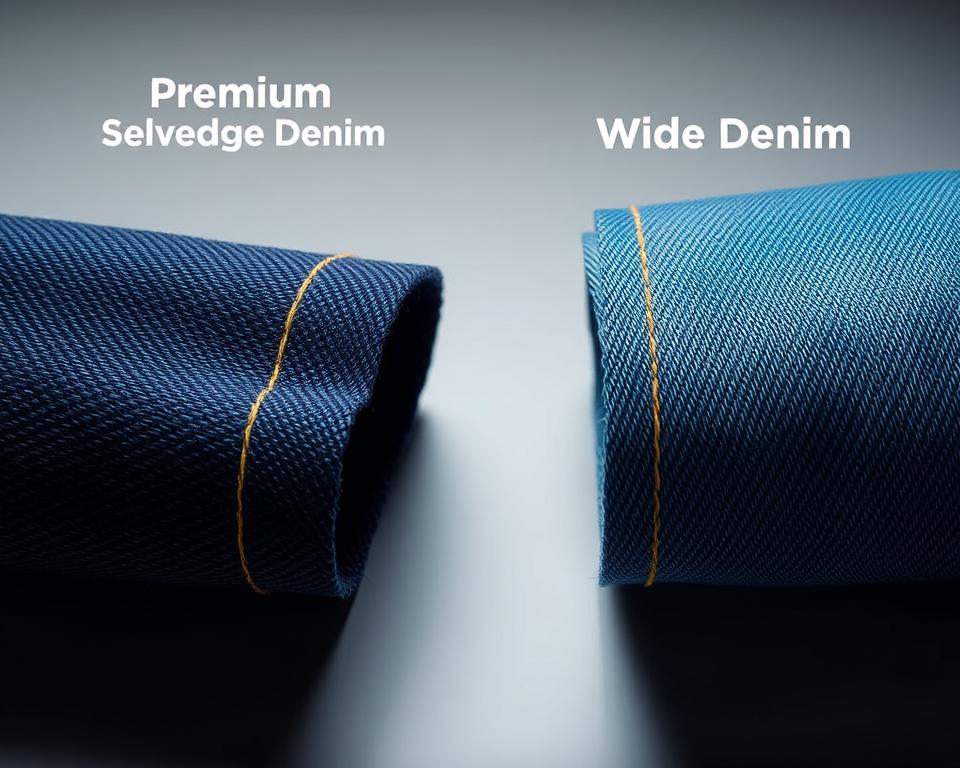Your Guide to Premium denim Selvedge Fabric
Ever pondered why some jeans feel like they’re designed for longevity a lifetime? Everything revolves around the components and craftsmanship. Take, for instance, the increasing trend of high-end selvedge. It’s not merely ordinary material—it attests to superiority and tradition.
Nowadays, more people are opting for these classic materials for their durability and classic selvedge denim fabric allure. Be it that you are a do-it-yourself sewist or a denim aficionado, there’s a unique quality about working with top-grade natural fiber and stitching. It’s not just about constructing pants; it’s about producing a narrative.
Within Core Fabrics, we’ve selected a selection of 14.25oz eco-friendly cotton and stretch variants. These materials are tailor-made for a spectrum ranging from raw jeans to designer jacket designs. Eager to discover the universe of premium fabrics? Let’s dive in.
Understanding Denim Selvedge Fabric?
What is it that makes some jeans distinguish themselves with their signature, naturally edged edges? The key resides in the selvedge denim, a high-quality material known for its robustness and old-school appeal. In contrast to standard textiles, this fabric is fashioned using traditional methods that have stood the test of time.
Understanding Selvedge Denim
Selvedge denim is manufactured using vintage shuttle looms, which generate slender widths of about 30-35 inches. They intertwine the textile in a way that creates self-finished edges, often marked by a signature red line. Such a process guarantees the material is firmly crafted and highly durable.
Contemporary looms, on the other hand, yield expansive fabric but lack the comparable degree of craftsmanship. Minor flaws in selvedge, like misaligned seams or irregular surfaces, are embraced as part of its charm. This philosophy, termed “wabi-sabi”, celebrates the appeal of natural flaws.
Production of Selvedge Denim
The production of selvedge denim entails a detailed process. Shuttle looms interlace the filling yarns in alternating directions, forming a compact and resilient fabric. This method contrasts with new-age looms, which emphasize rapid output over durability.
Companies such as Karson Denim preserve vintage Japanese craft practices from the 1990s. They purposefully add anomalies to maintain the authenticity of the textile. Each piece is evaluated on a 4-point system, confirming it fulfills the highest standards of excellence.
| Feature | Selvedge Denim | Current Denim |
|---|---|---|
| Span | 30-35 inches | 60+ inches |
| Construction Technique | Classic Shuttle Loom | Contemporary Loom |
| Texture | Non-uniform, Raw | Uniform |
| Durability | High | Moderate |
“The allure of selvedge lies in its imperfections—each irregularity speaks of craftsmanship and tradition.”
The History of Selvedge Denim
From humble beginnings to worldwide renown, the tale of these materials is rich and inspiring. Initially designed as hardwearing clothing in the 17th-century France has become a signifier of everlasting fashion and craftsmanship.
Historical Roots
The roots of this fabric reaches back to Nîmes, France, where it was known as “serge de Nîmes.” First intended for the working class, it was crafted out of hardwearing cotton and stitching. Its resilience rendered it beloved among the workforce during the historic Gold Rush.
During the twentieth century, it had transformed into a cornerstone for trousers. The closure of the Cone Mills White Oak factory marked a turning point. This transition paved the way for Japanese artisans to restore classic fabric-making practices.

Modern Developments in Denim
Following WWII, Japan adopted old-school American culture. Craftsmen restored antique looms to create authentic reproductions. This commitment to artistry guaranteed the continuance of selvedge as a specialty product.
In modern times, breakthroughs from Italy and Turkey have introduced sustainable blends and flexible options. These improvements have enhanced the appeal of this classic fabric. At Core Fabrics, we gather worldwide, from Montréal to Asia, to deliver to you the finest quality.
“The history of selvedge is a testament to the enduring value of craftsmanship and legacy.”
Why Choose Selvedge Denim?
What makes selvedge denim distinguish itself in the universe of premium textiles? Its distinct attributes and unmatched durability render it popular among enthusiasts and stylists alike. Be it that you are crafting trousers or a structured jacket, this textile delivers a fusion of classic methods and updated style.
Unique Qualities of Selvedge Fabric
Selvedge denim is known for its dense construction, which enhances ripping resistance and wear patterns. In contrast to common fabrics, rainbow selvedge denim is produced using classic shuttle looms, creating a more compact and exceptionally sturdy fabric. This process ensures that all products boast a distinct surface and individuality.
Here’s what makes it special:
- Hairy, rigid raw denim juxtaposes against softened, pre-washed stretch fabrics.
- The sanforization process ensures predictable sizing, while raw options offer a unique shrinkage journey.
- Weight options range from 9.5oz Eco Finish to 14.25oz Organic, catering to different needs.
Robustness and Endurance
One of the key attributes of selvedge denim is its long life. The tighter weave boosts robustness while enabling distinctive color fades over time. This establishes it as a wise purchase for those looking for enduring style.
Main considerations:
- 12-14oz weights are ideal for structured jackets and jeans that soften with age.
- Opt for the 14.25oz True Indigo for traditional jean lifespan.
- Eco-friendly options, like recycled cotton and indigo blends, add sustainability to your wardrobe.
Core Fabrics offers an assortment of products tailored for every requirement. Spanning from raw finishes to sanforized treatments, each selection is designed for superior quality and value.
Selvedge vs. Wide Denim: A Comparison
In the creation of robust and fashionable apparel, the selection of textile matters significantly. Two popular options are selvedge and wide denim, both offering different features. Comprehending their variances guides the ideal material for your project.
Contrasting Weave Techniques
Selvedge denim is woven on time-honored shuttle looms, yielding limited spans of 30-35 inches. This selvedge denim jacket process creates firm borders, often accented with a distinctive red line. Wide denim, on the other hand, uses modern projectile looms, resulting in expansive widths of over 60 inches.
Old-style shuttle looms yield roughly 3m per minute, while projectile looms can produce up to 30 meters per minute. This difference in speed impacts both the cost and the texture of the end result.
Advantages and Disadvantages
Selvedge denim is renowned for its high-end construction and robustness. Its narrow width renders it perfect for applications where visible hems or patches are desired. However, it can be pricier, averaging $23 per meter.
Wide denim is budget-friendly, priced around $8 per half-meter. Its broader span minimizes excess, well-suited to big-scale works like interior décor projects. However, it falls short of the signature finished border of selvedge.
| Attribute | Selvedge Denim | Wide Denim |
|---|---|---|
| Span | 30-35 inches | 60+ inches |
| Weaving Process | Traditional Shuttle | Projectile Loom |
| Production Speed | 3 meters per minute | 30m/min |
| Expense | $23 per meter | $8 per half-meter |
When precise, structured edges are required—as in Grainline Thayer jackets—selvedge wins out. Conversely, wide denim is ideal for extensive projects due to its efficiency. Weigh your requirements carefully to decide.
How to Use Selvedge Denim
Utilizing superior fabrics can transform your sewing endeavors. Be it making pants, blazers, or skirts, understanding the basics of yardage, sewing techniques, and care ensures a professional finish. Let’s delve into the optimal use of this everlasting fabric.
Yardage Needed for Jeans and Jackets
It is essential to compute the correct fabric amount when designing your creation. Men’s jeans typically require roughly 3-3.3 yards, factoring in flaws and potential shrinkage. Trucker jackets typically require 3.3 yards, while a skirt often needs 2 yards.
Smart pattern positioning minimizes the impact of defects. Embrace the natural defects by weaving them into your creative design.
| Garment | Required Yardage |
|---|---|
| Men’s Jeans | 3 to 3.3 yards |
| Trucker Jacket | 3.3 yards |
| Skirt Item | 2 yards |
Tips for Sewing and Care
Employing proper equipment and methods leads to an impeccable finish. Select #70-110 needles and presser foot attachments designed for heavy materials. For contrast stitching, Gütermann rPET thread is a reliable choice.
Additional advice includes:
- Employ a tailor’s clapper to achieve crisp creases without gloss.
- Core Fabrics’ denim kits include topstitch thread, rivets, and 9mm jeans buttons for a professional finish.
- Structured edges, essential for jackets, are best achieved with selvedge.
Correct care ensures your garments last longer. Wash sparingly and air dry to maintain the material’s integrity. Adhering to these practices will sustain your creations for years.
Bringing It All Together
Crafting with premium materials isn’t just about durability—it’s about creating something with character. Selvedge denim exemplifies this philosophy, fusing handcrafted appeal with enduring excellence. From jeans to tailored jackets, every stitch of this material conveys a narrative.
With Core Fabrics, unleashing your creative potential is effortless. Try our swatch service to feel the texture and weight before committing. Furthermore, take advantage of free shipping for orders above $150 USD in North America.
Eco-friendly mixtures and classic washes are paving the way for the next generation of cotton fabrics. These trends offer new ways to add sustainability and style to your wardrobe.
Eager to explore top-tier textiles? Shop now and discover the value of crafting with purpose. Your next project could be a timeless piece that lasts for years to come.

